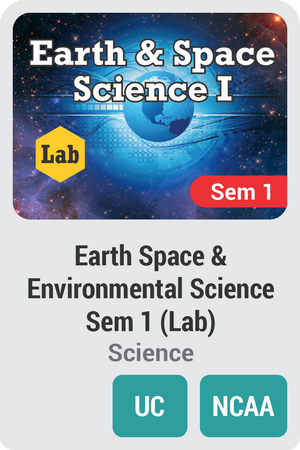
Course Overview:
This course introduces the student to the history of earth, earth’s formation and life cycle of stars. Students learn about formation of continental & ocean-floor features, earth’s interior and earth’s feedback systems. They study about the importance of water and the co-evolution of earth’s systems and life on earth. The course teaches students about modeling flow of energy in earth’s systems & earth’s climate. This course emphasizes the importance of managing earth’s resources and students get an appreciation of earth’s influence on human activity including natural hazards. The true cost of fossil fuels, the perils of energy production and alternate forms of energy are discussed. Students study & analyze several case studies related to energy production and alternate forms of energy.
Note: This course is not designed for ELL (English Language Learners) students. ELL students may enroll in this course ONLY if they have adequate mentor support at their home school and are able to fulfill all course requirements.
Prerequisites:
Middle School ScienceRequired Materials:
- Magnifying Lens
- Ruler
- Coins: Penny, cent, quarter
- Permanent Marker
- A sheet to record data (lab sheet)
- Milky way candy bar (3)
- 3 sheets of paper
- Pencil
- Cardboard box (used previously for packaging) – at least 1 foot in dimension (30 cm)
- Flashlight
- Tape (masking or scotch)
- Support (Large firm book/cutting board/large cardboard piece) – at least 1.5 feet tall and 1.5 feet wide (45 cm X 45 cm)
- Protractor
- Graph paper with line spacing of 5mm
- Different colored pens
- Cardboard at least 1.5 feet on each side (4 cm X 45 cm)
- An empty plastic gallon milk jug
- Water
- Nail
- Tape Measure
- Permanent Marker
- Timer (can be on phone)
Syllabus:
Section 1 - History of the Planet Earth
Objectives:
- Big Bang Theory, Spectra from the Stars and Kepler’s Laws
- How Stars Produce Energy and the Life Cycle of stars – including the Birth and Evolution of stars
- The Different Theories explaining the Formation of Earth, Dating Techniques, Stratigraphic laws, and Fossils & Evolution of Life
- Plate Tectonics theory and Evidence for the Movement of Continents
Lessons:
- Our Universe
- Life Of Stars
- Earth’s Formation and Early History
- Earth’s Early History (Continued)
Section 2: Earth’s Systems and Processes
Objectives:
- Formation of Continental & Ocean-Floor Features
- Internal Structure of the Earth
- Earth’s Feedback Systems, Earth’s Atmosphere & Hydrosphere, Weather & Climate
- Physical & Chemical Properties of Water
- Co-evolution of Earth’s Systems (Atmosphere & Hydrosphere) & Life on Earth (Biosphere)
Lessons:
- Formation of Continental and Ocean Floor Features
- Earth’s Interior
- Earth’s Feedback Systems
- Earth’s Water
- Co-Evolution of Earth’s Systems & Life on Earth
Section 3: Weather and Climate
Objectives:
- Modeling Flow of Energy in Earth’s Systems, Climate and its Variability, the Ozone Layer, the Carbon Cycle
- Climate Change, Global Climate Models, and Sea Level Rise
- Management of Earth’s Resources, Human Impact on Earth’s Resources, and Human Sustainability Initiatives
Lessons:
- Modeling Flow of Energy in Earth’s Systems
- Modeling Earth’s Climate
- Management of Natural Resources
Section 4: Earth’s Natural Resources and Climate’s Influence on Human Activity
Objectives:
- Earth’s Varied Natural Resources – their Origins, Classification, Distribution & Impact on Humans
- Natural Hazards and their Impact on Humans
- Classification of Earth’s Natural Regions
- Influence of Earth’s Resources & Climate on Human Activity
Lessons:
- Natural Resources
- Natural Hazards
- Natural Regions
- Earth’s Climate and Human Activity
Section 5: Human Impact on Earth and Climate
Objectives:
- The Importance of Managing Earth’s Resources, and How Human-Induced Hazards are Affecting Earth & Humans
- Fossil Fuels & their Impact on Earth & Climate
- Risks Associated with Energy Production (2 Case Studies)
- Sustainable Practices and Alternate Energy Solutions
- Case Study on How Science & Engineering Can Solve the World’s Complex Problems
Lessons:
- Managing Earth’s Resources
- The True Cost of Fossil Fuels
- Perils of Energy Production
- Alternative Energy Solutions
- Case Study: How Science & Engineering can Solve Complex Problems


